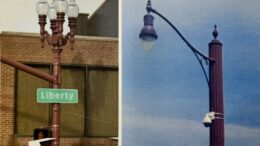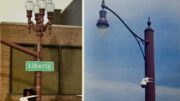The philosophy behind blueberry pruning is to constantly renew the older, decreasingly productive canes by cutting them out and forcing new canes. The plant is continually replacing old canes with new canes, while the majority of the canes are in a productive, intermediate stage.
Pruning is best accomplished toward the end of the dormant season, usually sometime in March. Fall pruning is not recommended since it can force the plant to produce new shoots that will be killed by winter cold. In March, fruit buds are easily recognizable since they are plumper than vegetative buds. For the first growing season, all of these fruit buds should be removed. This forces vegetative growth in the plant. This first year should be spent establishing the plant, which, if properly cared for, will bear fruit for 50 years or more.
To prune, first remove small, spindly branches and canes that lie on the ground. When thinning canes, try to maximize light conditions inside the plant by removing the centermost canes, which block the sunlight. Once the plant is mature (6 years old), it should be producing three to five new shoots per year. If it is not, check your fertilizer program. The production of new shoots is somewhat variety dependent, and some may not respond as well as others. Every year, select the best two to three new canes to retain. After 5 years, begin removing the oldest (5 years or older) canes while retaining the three best new canes. This will result in a plant that has two to three canes each of new, 1-, 2-, 3-, and 4-year-old canes, or 10 to 15 canes. As with any biological system, this is an optimal range–many plants will deviate from this ideal.
After removing the canes, thin those that remain. To do this, remove weak lateral branches and dense bushy twigs. Thin out the center of erect varieties while removing the low-spreading growth of more spreading varieties. Long canes with many flower buds also should be headed back to remove some of the crop. Bear in mind that thicker wood will bear larger berries, which bloom slightly later. The later blooming can be an advantage where late frosts are a problem. If plants have not been pruned for many years, they can be rejuvenated by cutting back all of the canes and allowing regrowth, or by cutting back half the canes in one year and half in the following year. The latter method may be preferred, since it prevents a lapse in cropping.
Spreading (Open) Growth Habit
Most of the pruning of plants in this category should be directed to the outer edge of the bush. Keeping the growth habit pruned to a more erect form facilitates cultural operations and harvesting. Recommended for Berkeley, Bluetta, Coville, Patriot and Weymouth.
Upright (Erect) Habit
Plants in this category become dense in the center, which causes shading that reduces both shoot formation and flower bud initiation. Remove the older central canes to produce a better growth situation. Recommended for Bluecrop, Blueray, Collins, Darrow, Earliblue, Elliot, Herbert, Jersey and Lateblue.
Vigorous Varieties
Plants in this category yield better when “thinned out” rather than “detail” pruned. The entire removal of older canes (6 years and older) has a beneficial effect on yield and growth. This is especially applicable for Blueray, Collins, Coville, Earliblue and Herbert.
Weak (Slow-Growing) Varieties
These plants usually produce many short, weak shoots that lack productivity. Detailed pruning (removing short, one-year growth) will improve overall berry quality on the remaining shoots. The systematic removal of thin shoots (less than 1/8 inch in diameter) and those less than 6 inches long will improve fruit quality. This is of special importance when pruning Bluetta.








































